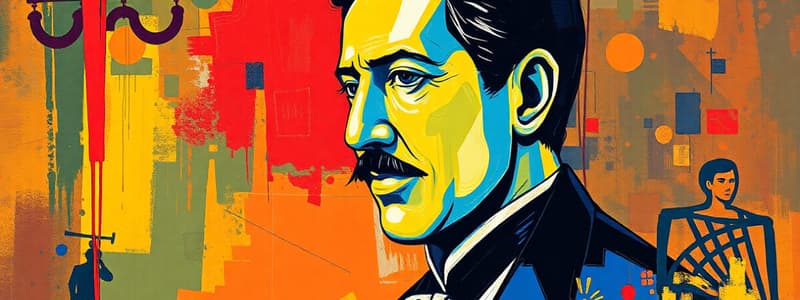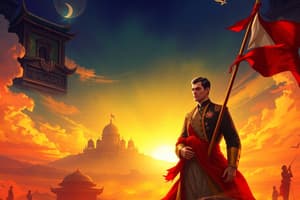Podcast
Questions and Answers
What event marked the end of liberal policies in the Philippines?
What event marked the end of liberal policies in the Philippines?
- The appointment of General Rafael Izquierdo (correct)
- The execution of GOMBURZA
- The arrival of Carlos Ma. de la Torre
- The Cavite Mutiny
Carlos Ma. de la Torre's liberal regime was not welcomed by Spaniards.
Carlos Ma. de la Torre's liberal regime was not welcomed by Spaniards.
False (B)
What agricultural activity was Calamba known for during Rizal's birth?
What agricultural activity was Calamba known for during Rizal's birth?
sugar production
The Cavite Mutiny broke out under the leadership of Sergeant La ______.
The Cavite Mutiny broke out under the leadership of Sergeant La ______.
Match the following individuals/events with their description:
Match the following individuals/events with their description:
What is the main goal of Rizal Law?
What is the main goal of Rizal Law?
Rizal Law mandates the inclusion of Rizal's works in the curricula of all schools, colleges, and universities.
Rizal Law mandates the inclusion of Rizal's works in the curricula of all schools, colleges, and universities.
What are the titles of the two novels by Jose Rizal that are specifically mentioned in Rizal Law?
What are the titles of the two novels by Jose Rizal that are specifically mentioned in Rizal Law?
Rizal Law is also known as Republic Act number _________.
Rizal Law is also known as Republic Act number _________.
According to Rizal Law, what should schools, colleges, and universities maintain in their libraries?
According to Rizal Law, what should schools, colleges, and universities maintain in their libraries?
Flashcards
Rizal Law
Rizal Law
An Act mandating the study of Jose Rizal's life and works in educational institutions.
Main Goals of Rizal Course
Main Goals of Rizal Course
Recognize Rizal’s relevance, apply his ideas to contemporary issues, and develop moral character.
Noli Me Tangere
Noli Me Tangere
One of Jose Rizal's novels included in the curriculum by the Rizal Law.
El Filibusterismo
El Filibusterismo
Signup and view all the flashcards
Rizal’s Tribute to Heroes
Rizal’s Tribute to Heroes
Signup and view all the flashcards
Cavite Mutiny
Cavite Mutiny
Signup and view all the flashcards
General Carlos Maria de la Torre
General Carlos Maria de la Torre
Signup and view all the flashcards
Execution of GOMBURZA
Execution of GOMBURZA
Signup and view all the flashcards
Liberal regime of Carlos Ma.de la Torre
Liberal regime of Carlos Ma.de la Torre
Signup and view all the flashcards
Calamba during Rizal's birth
Calamba during Rizal's birth
Signup and view all the flashcards
Study Notes
Lesson 1
- Introduction to the Course: Why Study the Life and Works of Rizal?
History of the Rizal Law and Its Essential Provisions
- Gen. Emilio Aguinaldo made December 30th the anniversary of Jose Rizal's death.
- Rizal was declared the Philippine National Hero in 1901.
- The Taft Commission renamed the district of Morong to the Province of Rizal.
- Rizal's death anniversary was made an official holiday.
- Act No. 243 was enacted on September 28, 1901, granting the right to use public land in Manila to erect a statue of Jose Rizal.
- The Rizal National Centennial Commission was created in 1961 by Pres. Ramon Magsaysay to prepare for the birth centenary of Jose Rizal. This commission was tasked with undertaking the construction of a National Cultural Shrine.
- The commission transformed into the Rizal Presidential Committee on July 1, 1962, during the Diosdado Macapagal administration.
- Jose Rizal's role in the attainment of the nation's freedom led to the issuance of Republic Act 1425 on June 12, 1956, commonly known as the Rizal Act.
- Claro M. Recto authored the Rizal bill, while Senator Jose P. Laurel, Sr., sponsored it in the Senate.
- Republic Act No. 1425 mandates the inclusion of courses on the life, works, and writings of Jose Rizal, particularly his novels Noli Me Tangere and El Filibusterismo, in all public and private schools, colleges, and universities curricula.
Rizal Law and the Study of Life and Works of Rizal
- Rizal was the founder of Filipino nationality and the architect of the Filipino nation.
- The study of Rizal's life, teachings, and writings will give Filipino youth incorruptible confidence, direction, courage, and determination to move forward.
- Other reasons for teaching the Rizal course include recognizing Rizal's ideals, teachings, and values in relation to present conditions and situations in society. Applying his ideas for present-day solutions and fostering the development of moral character in Filipino youth for citizenship.
The Philippines in the 19th Century: Social and Political Structure
-
Glossary of Terms:
- Peninsulares: Spaniards born in Spain and living in the Philippines.
- Insulares: Spaniards born in the Philippines.
- Indios: Native Filipinos, sometimes called Filipinos in some accounts, as per this study.
- Mestizos: People of mixed ancestry, including Chinese-Filipino and Spanish-Filipino.
-
The term Filipino was used only after the Spanish rule in 1898. Historically, the term was used to refer to the natives of the country.
-
Social pyramid in the Spanish colonial period shows Peninsulares at the top; Insulares, mestizos, principalia in the middle; and Indios at the bottom. The Spaniards held most important government jobs. _ The middle class consisted of Spanish (and some Chinese) mestizos, principalia, and native Filipino elites, such as cabezas de barangay and landowners. The lowest class was made up of native Filipinos, known as Indios, representing the majority of the population. Native Filipinos were controlled by the friars.
-
Filipinos in the lower classes were considered inferior in education and government positions to those in upper classes.
-
Social Structure during Spanish colonial period: The social structure consisted of three levels: Peninsulares; Insulares, mestizos, principalia; and Indios or Filipino natives.
-
Filipino Social Structure: The Spanish colonial government implemented a feudal system that resulted in master-slave relationships and the collection of taxes and tributes from native Filipinos.. Lands were owned by the rich Spanish officials, businessmen, and friars, and native Filipinos became tenants.
-
This social structure affected education, as schooling was primarily for the rich, native, and Spanish upper classes.
-
Political System (administrative organization)
- The Philippines was ruled directly by the Spanish Crown through the Ministry of Colonies in the 19th century, primarily through appointed Governor-Generals.
- Central government, in Manila, was unitary and administered the entire country
- Pacified provinces (alcaldías) and unpacified provinces (corregimientos) were administered differently.
- Local government included roles like maintaining peace, collecting taxes, and public works projects.
-
The Residencia: To evaluate the performance of replaced Spanish governors, a special court.
-
The Visita: Spanish government officials who investigated conditions in the colony and reported to the King.
-
Union of the Church and State: The friars were the local representatives of the Spanish government and oversaw local affairs.
-
Guardia Civil: Native police force established in 1867.
Economic Development & The Rise of Nationalism
- Pre-colonial trade relations existed with China, India, Indonesia, Malaysia, and Borneo.
- The opening of the Philippines to foreign trade ended the 18th century, creating business opportunities for Filipino natives. Agricultural produce, like sugar, rice, hemp, and tobacco, was traded.
- This increased Filipino contacts with Spaniards, exposing them to the freedoms and rights of other people.
- The rise of the Chinese-Filipino middle class contributed to the growth of the economy
- Increased trade enabled the sending of Filipinos to Europe, where they learned about Western culture and ideas. These educated Filipinos played important roles in shaping the nation.
- Increase in prosperity to Filipino middle and upper classes.
The Rise of Nationalism
- Nationalism is a political ideology that involves an individual identifying with one's nation. A feeling and sentiment of a group of people.
- The birth of Filipino nationalism was gradual, due to factors like topography, language barriers, and Spanish colonial policy.
- Nationalism arose from economic, political, and cultural factors.
- The rise of the middle class,
- Spread of liberal ideas through books, newspapers, and foreign travel, and
- The Secularization Movement (conflict between regular priests and secular priests, who managed parishes and were supervised by bishops).
- The Liberal regime of Carlos Maria de la Torre(1869): welcomed by both Filipinos and Spaniards, practiced liberal and democratic principles and also settled agrarian unrest (disputes between the rich and poor).
- Cavite Mutiny (1872): marked the end of liberalism in the Philippines
- This uprising resulted in the execution of three Filipino priests, known as the GOMBURZA, for charges of subversion.
Rizal's Family and Ancestry
- Rizal's family was a middle-class family (principalia).
- They were farmers, and had a house and possessions that suggested they were wealthy in their community.
- Rizal's parents were educated, which led to the education and training of their children, including Jose Rizal himself.
- Rizal came from a mixed ancestry: Chinese, Filipino, Spanish and Japanese ancestry.
- His mother was involved in managing and protecting her family during a period of hardship for the family.
- His father was involved in teaching and education.
Rizal's Childhood Memories and Influences
- Rizal had a happy childhood because his parents were hardworking and his mother managed their family well.
- His mother was his first teacher, who taught him the Roman alphabet and prayer.
- Rizal observed instances of violence directed at some people by the local government and the Guardia Civil.
- His younger sister's death caused great sorrow, and it deeply affected him.
- His trip to Manila was a memorable trip since it was important for him to go to Calamba and reunites with his parents and siblings.
From Calamba to Biñan: Early Education
- His formal education began in Biñan with Maestro Justiniano Cruz.
- Rizal was involved in school fights.
- His classmates were jealous of his learning ability.
- Rizal received a letter from his sister informing him that a ship was coming to take him to Calamba. He visited the town church and then collected pebbles as mementos, and said goodbye to his teacher and classmates.
From Ateneo to UST: Higher Education
- Rizal enrolled in Colegio de San Juan de Letran in Manila and passed a qualifying examination.
- He was rejected, at first, from the local Ateneo Municipal school (Jesuit-run institution) after being told that he was late for registration.
- During his intervention, Manuel Burgos - Fr. Jose Burgos, nephew - helped him enroll.
- He adopted the surname Rizal, as his brother used it previously.
- Rizal attended the Ateneo in Manila.
- Rizal enrolled in the University of Santo Tomas.
- He decided to enroll in Philosophy and Letters during his first year
- He pursued a course in medicine.
- Difficulties included loneliness due to his mother's arrest, Filipino discrimination in the university and poor academic performance.
Rizal as a Lover
- Rizal was highly documented as a nationalist, very devoted, and brave.
- He focused on unifying Filipinos, developing networks, and building connections through the Propaganda Movement
Studying That Suits You
Use AI to generate personalized quizzes and flashcards to suit your learning preferences.




